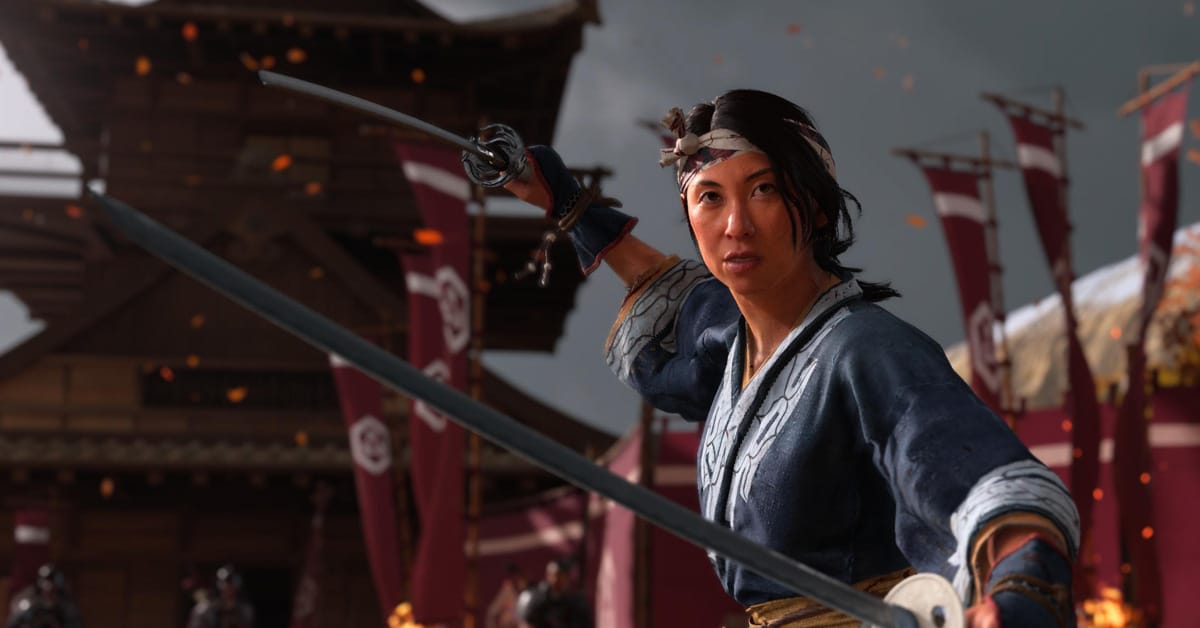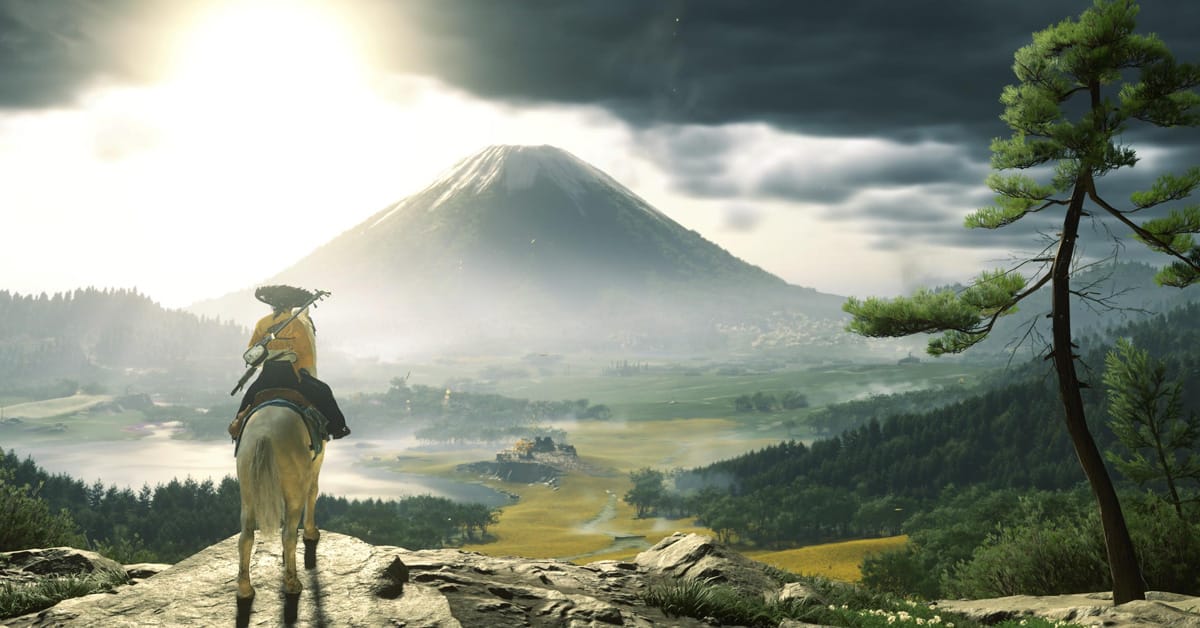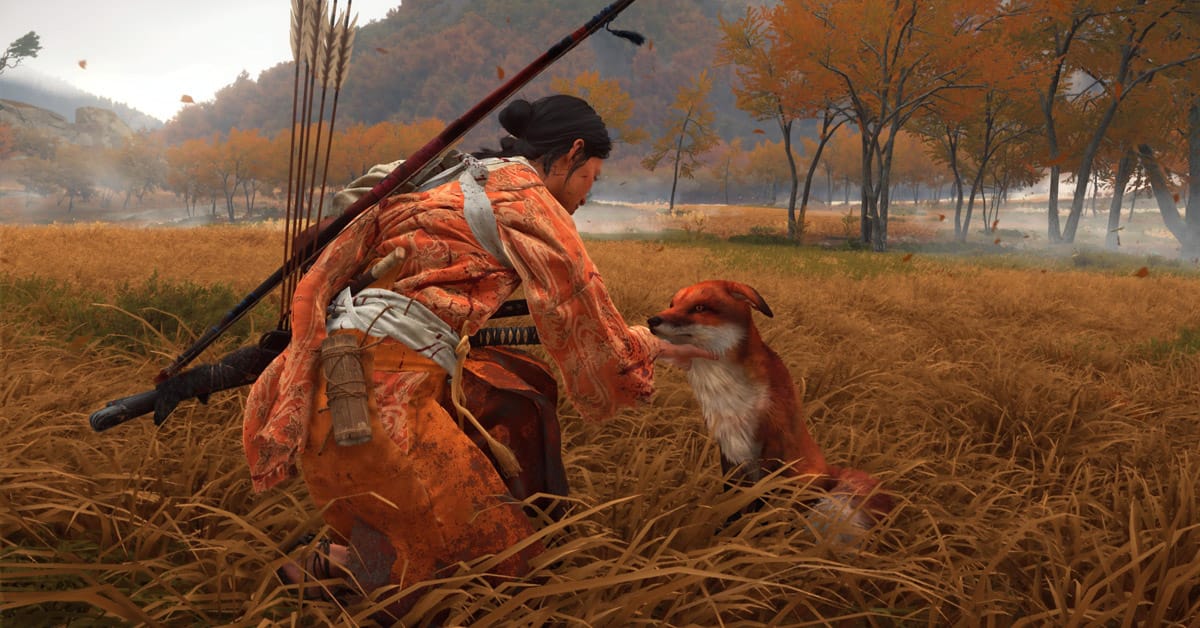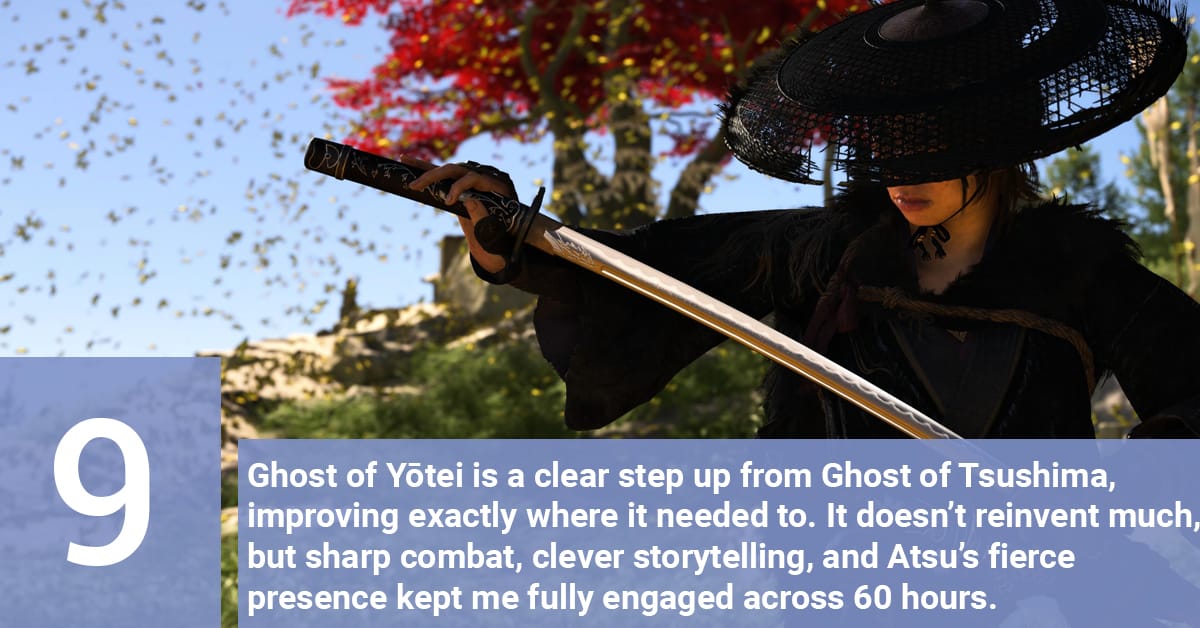While most gamers were eagerly awaiting Ghost of Yōtei, I wasn’t convinced just yet. I thought its predecessor Ghost of Tsushima was a solid enough game, but the world, story, and protagonist started to bore me far too quickly. And judging from the trailers leading up to this sequel, everything looked eerily familiar.
Could Sucker Punch’s new action game really win me over this time? After about 60 hours of play, in which I followed dozens of foxes, chopped off hundreds of limbs, and liberated countless camps from hostile bastards, I’m here to give you the answer.
This review is spoiler-free.
A New Protagonist, a Breath of Fresh Air

Ghost of Yōtei (thankfully) leaves former protagonist Jin Sakai behind and replaces the stiff samurai with the mercenary Atsu. And to be honest, that’s already a victory in itself.
Unlike Jin, Atsu isn’t bound by the rigid samurai code. That code may be honorable, but it’s also predictable. Atsu operates without shackles, she colors outside the lines, and the game is better for it from the very first minute.
She follows her own code instead: crossing off the six names of those responsible for the murder of her family, the same people who left her for dead. The so-called Yotei Six are led by the powerful Lord Saito.
After sixteen years of wandering and honing her combat skills, she returns to her hometown of Ezo, ready to spill blood. A lot of blood.
Voice actress Erika Ishii deserves full praise for her performance. She brings Atsu to life as a broken but fiercely determined woman who will stop at nothing to achieve her goal.
It was always a thrill to hear Atsu being underestimated by her enemies. Ishii delivers simple threats like “you don’t want to do this” with an icy conviction. The character radiates confidence in her own abilities, and her lines consistently fired me up before every fight.
A Clichéd Revenge Story That Still Manages to Be Told in an Interesting Way

The way the not-very-original premise is handled surprised me in a good way. You get regular flashbacks, and sometimes you can even switch in real time between past and present.
Crucially, the massacre is not shown all at once. It’s broken into pieces, and every time the game needs to remind you why you should hate a specific target, it gives you another fragment.
That storytelling trick kept me curious about what else happened that night, and it also made me itch to shove one of those sadistic bastards onto Atsu’s sword.
Combat Is Still One of the Absolute Highlights

Between hunting down your six main targets, you’ll constantly be dealing with plenty of “fodder” enemies begging for a beating. And handing it out feels fantastic. Combat is fast, visually impressive, the animations are awesome, and despite the hundreds of battles I ended up in, I never once got bored.
With your katana you can mix quick and heavy strikes, block, parry, and dodge. You can stagger enemies with a perfect parry, or just hack away until their guard drops.
But Atsu has more than just a katana at her disposal. You can use five main weapons in total: the katana, dual katanas, a yari (spear), the kusarigama (a chain-and-sickle weapon), and the odachi (a big-ass sword). Each weapon has its own flashy move set and bloody finishers that look great every time.
You can swap freely, but it pays to use the right weapon for the right opponent. The katana is best against other katana users, the kusarigama is perfect for breaking shields, and dual katanas shine against spear-wielding enemies. The game makes sure you understand this by introducing it clearly, with NPCs giving you little “exams” to test your knowledge. For a forgetful gamer like me, that was actually pretty handy.
“Combat is fast, visually impressive, the animations are awesome, and despite the hundreds of battles I ended up in, I never once got bored.”
As if five melee weapons weren’t enough, you also have access to multiple bows, each with different arrow types like fire arrows, poison arrows, or even arrows that disarm enemies.
And we’re still not done. You also get throwables, such as kunai or bombs, with several variations to choose from. Just like in Ghost of Tsushima, I sometimes found it tricky to juggle all these tools in the middle of a fight, so I mostly stuck with the five main weapons.
The throwables I did use a lot were the ones you pick up from the ground. Loose swords, spears, or knives can be kicked up and hurled through an enemy with one button press. Sometimes Atsu flicks a blade into the air with her foot first, and that animation looks incredibly cool. It’s stylish, effective, and never got old.
The AI of Enemies and Companions Is a Big Step Up

While I enjoyed Tsushima’s combat, I found it a little too easy. That’s why I decided to play Ghost of Yōtei on hard from the start (something I only regretted in the very last fight…). Every battle felt like a spectacle.
Enemies strike fast and without mercy. The biggest change is that they no longer politely wait their turn. A brute with a massive sword will come at you while one of his quick buddies tries to stick you with a pair of daggers, all as archers pepper you from a distance (and thankfully they no longer yell DOOSHOO nonstop).
This forces you to stay on your toes at all times and pick the right moments to switch between defense and offense.
It’s not just enemy AI that’s improved. I noticed that whenever I had a companion at my side, they actually covered me. My allies would often mirror my movements to take some of the pressure off, which is something I rarely see in games. It was a pleasant surprise.
Even Stealth Feels Great

In many encounters you can also choose to take out your targets quietly. Making stealth genuinely fun is tricky, but Sucker Punch nails it. It takes a few skill points to really shine, but once I invested in the Assassination tree, I could operate like a true shinobi (without having to feel guilty about it, this time around).
You can assassinate enemies from behind or leap on them from above. With some upgrades you unlock chain assassinations, letting Atsu slice down up to three enemies in an instant. The kusarigama can even be used to silently drag an unsuspecting foe down from a distance.
If you rack up enough kills without taking damage, you unlock Onryō’s Howl (essentially the Ghost Stance from Tsushima). It terrifies your enemies and lets you finish them off with ease. Perfect for those moments when a stealth run doesn’t go quite as planned.
And once again, it all looks fantastic. Ghost of Yōtei constantly makes you feel like a complete badass.
You Can Shape Different Builds Through Charms and Outfits

Whether you prefer going in loud, sneaking around, or fighting from a distance, there’s always a charm or outfit to help you get the most out of your skills.
You can equip a mix of major and minor charms, and the more you collect, the more major slots become available.
The bonuses cover just about everything: more health, extra spirit (used for special skills and healing), firing multiple arrows at once, automatic healing when you’re low — if you can think of it, there’s probably a charm for it.
By pairing these charms with outfits, each with their own perks, you can create a build that matches your playstyle. You can set up to five loadouts and swap between them easily in the gear menu.
Many charms can also be upgraded by meeting certain conditions, like visiting a number of hot springs or stunning a set amount of katana-wielding enemies. Outfits can be upgraded too, using money and materials you find by chasing bounties or exploring the game’s artistic world.
Ezo in 1603 Looks Artistic and Stunning

While playing Ghost of Yōtei, I couldn’t help but compare it to its genre-mate Assassin’s Creed Shadows. Even though I still haven’t finished Shadows (and probably never will), one thing became clear: playing Yōtei reminded me just how gorgeous Shadows’ environments are.
That doesn’t mean Sucker Punch’s game lacks beauty. Where Shadows chases photorealism, Yōtei leans into an artistic, charming style. Colorful flowers bloom everywhere, and their petals constantly drift and flutter through the air.
The wind guides you to your active quest or the place you’ve marked on the map. Swipe up on the touchpad and a gust picks up, meaning you don’t need a quest marker. It’s a clean, elegant design choice carried over from Tsushima. Still, I often had to open the map, because the times I tried to follow the wind blindly, I usually ended up on the wrong side of the map.
That wasn’t only down to my inability to follow the wind, though. It’s also because there are so many distractions along the way. And I mean that in the best way. Every time I set out for a destination, I’d stumble on something else worth chasing.
The Beginning and End of Many Activities Are the Same, but the Path in Between Has Been Improved

Golden birds return, leading you to interesting spots like hot springs or bamboo strikes. Bathing grants extra health, while bamboo strikes increase your spirit. The latter still involves following an increasingly long button sequence, and they’re still fun to pull off.
In the previous game I often skipped these bonuses, but in Yōtei I made use of almost all of them. The tougher combat made me want to grab every advantage I could find. The synergy between the fighting and the rewards you get from exploring works much better this time. One wouldn’t feel as valuable without the other.
But it goes further than that. Tsushima had hot springs, bamboo strikes, and haiku spots that rewarded you with new headbands or hats. What it lacked was a sense that the world itself was alive. Granted, the country was ravaged by war, but still…
Within half an hour Yōtei eased that worry. I stumbled on a campfire surrounded by travelers. After striking up a conversation, I received a lead on one of my targets, which was then added to the map. Nothing forced me to visit that campfire; I could have gotten the lead another way.
“The synergy between the fighting and the rewards you get from exploring works much better this time. One wouldn’t feel as valuable without the other.”
Another example: following foxes, something Tsushima players will remember. They used to always lead you to charms. This time,,,well, they still do. But there’s more unpredictability now. One fox led me to a man in need. I rescued him, we talked, and he in turn led me to the charm.
So yes, the start and end points in Ghost of Yōtei are still often the same. But the journey in between has been expanded and made much more engaging.
The world and the way quests link together are cleverly designed. There’s a lot of overlap between activities, and both Atsu and the NPCs acknowledge when something has already been done, like freeing a prisoner. The quest then adapts, making everything feel like one smooth, continuous experience.
It’s Not Just Recycling Old Activities; Thankfully Some New Ones Are Introduced

In Ghost of Yōtei you’re no longer just chasing fox dens. There are now wolf dens as well. And before you roll your eyes, believe me, they’re worth it.
In battle you’ll often get unexpected help from a wolf. It’s a fitting metaphor too, since Atsu and her twin brother Jubei were once called the Twin Wolves by their parents.
If you’re lucky, the wolf might even save you from death, lunging at an enemy just before they finish you off. Your health is restored and you’re right back in the fight.
When you find a wolf den, you can follow the wolf to a spot where Saito’s men have captured some of its kin. Team up with the wolf to take them out, and you’ll earn a skill point to invest in the Wolf Tree.
These points let you improve the wolf’s presence by making it show up more often or hit harder. Upgrades include things like the wolf performing a fatal follow-up attack after you throw a jar at an enemy, dealing extra stagger damage, or simply staying by your side for a longer stretch of combat.
The wolf even lends a hand during Standoffs, taking one of your opponents for itself. It’s useful, and just awesome to watch.
If you’d rather work alone, you can disable the wolf in the settings. But really, why would you do that to the bestest boy?
Another New Activity: We’ve Got a Board Game, Folks

I’m a simple man. Give me a good in-game minigame and I’m happy. The Witcher 3’s Gwent, Final Fantasy’s Queen’s Blood, Star Wars Outlaws’ Sabacc; I can lose hours to those.
So I was glad to stumble onto a Ghost minigame. The so-called Zeni Hajiki didn’t keep me hooked for hours like the ones above, but it was fun the few times I played it.
In Zeni Hajiki you and your opponent flick coins across the table. You’re only allowed to hit one coin at a time; touch more than one and your turn ends. Shoot too hard and send a coin flying off the table, and the point (and the turn) goes to your opponent.
The first to reach six points wins money or a charm. It’s a lighthearted break from all the bloodshed, though it won’t be ending up on my “best minigames of all time” list. One day I’ll make that list. Consider this a promise…
Some Loose Scraps

- The fact that Atsu literally wears her checklist of six names around her waist and crosses them off in blood is pretty badass.
- These darn fox puzzles really overstayed their welcome. They weren’t welcome in the first place.
- I recognize Noshir Dalal’s voice instantly at this point, as if he’s my father. Always a welcome presence, and once again he delivers a fantastic performance.
- The music in Ghost of Yōtei adds so much to the game’s strongest and most emotional moments. It’s beautiful.
- As a customization fan, I was spoiled with the wide range of cool outfits, hats, and masks.
- The Mythic Tale “The Crimson Kimono” is one of the most moving side quests I’ve played in a while.
- Speaking of Mythic Tales: make sure you don’t miss them in Chapter 3. Trust me on this.
- The standard cutscenes before every duel absolutely hit, and the duel locations look incredible. I had to take a screenshot every time.
- I’ve had a bit of an overdose of ancient Japan lately. I wouldn’t mind seeing Sucker Punch tackle something different next.
- That said, this game still managed to spark something in me that makes me want to give Shadows another shot.
- Erika Ishii also played one of the Rooks in Dragon Age: The Veilguard, Ben-Hwa in Date Everything, and Valkyrie in Apex Legends.
Conclusion

I’m a lot more positive about Ghost of Yōtei than I ever was about Ghost of Tsushima, that much is clear. The game improves across the board, exactly where it was needed most.
The flip side is that there’s not much truly new here. Things feel very familiar. It’s a big step up in execution, but not really in innovation.
That said, I had an excellent 60 hours with the game. Combat was a joy from start to finish, only getting better as Atsu grew stronger.
Stories about revenge have been told many times before, but this one packs enough twists and turns to keep it engaging, and Atsu as a protagonist held my attention from beginning to end.







